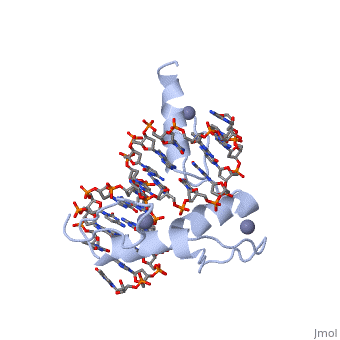User:James D Watson/Structural Templates
From Proteopedia
(→Secondary structure elements) |
|||
| Line 19: | Line 19: | ||
==Secondary structure elements== | ==Secondary structure elements== | ||
| - | |||
| - | ==About this Structure== | ||
| - | 5P21 is a [[Single protein]] structure of sequence from [http://en.wikipedia.org/wiki/Homo_sapiens Homo sapiens]. Full crystallographic information is available from [http://oca.weizmann.ac.il/oca-bin/ocashort?id=5P21 OCA]. | ||
| - | |||
| - | ==Reference== | ||
| - | Refined crystal structure of the triphosphate conformation of H-ras p21 at 1.35 A resolution: implications for the mechanism of GTP hydrolysis., Pai EF, Krengel U, Petsko GA, Goody RS, Kabsch W, Wittinghofer A, EMBO J. 1990 Aug;9(8):2351-9. | ||
| - | |||
| - | |||
| - | {{Clear}} | ||
| - | |||
| - | |||
| - | ==Structural superposition== | ||
| - | |||
| - | The viewer below left shows the structural superposition of the triphosphate conformation of H-ras p21 (PDB entry 5p21 <nowiki>-</nowiki> coloured orange) with Gdp-bound human rab21 gtpase (PDB entry 1z0i <nowiki>-</nowiki> coloured blue), the structural superposition was made using the MSDfold(SSM)[http://www.ebi.ac.uk/msd-srv/ssm/ 1] server at the EBI[http://www.ebi.ac.uk 2]. Note that the global fold of these two proteins is almost identical yet their sequence identity is only 29.6% (as determined using FASTA). The viewer below right shows the p-loops of both structures superposed. The ligands bound superpose particularly well and comparison of the two p-loops loops show significant structural similarity but also highlights the sequence differences between the two proteins. | ||
<applet load='5p21' size='350' frame='true' align='left' script='James_D_Watson/Proteins_Intro/Superposition_ras_structures/1' /> | <applet load='5p21' size='350' frame='true' align='left' script='James_D_Watson/Proteins_Intro/Superposition_ras_structures/1' /> | ||
<applet load='5p21' size='350' frame='true' align='right' script='James_D_Watson/Proteins_Intro/Superposition_ras_ploops/2' /> | <applet load='5p21' size='350' frame='true' align='right' script='James_D_Watson/Proteins_Intro/Superposition_ras_ploops/2' /> | ||
| - | |||
| - | |||
| - | {{Clear}} | ||
| - | |||
| - | ==This is a placeholder== | ||
| - | This is a placeholder text to help you get started in | ||
| - | placing a Jmol applet on your page. At any time, click | ||
| - | "Show Preview" at the bottom of this page to see how it goes. | ||
| - | |||
| - | Replace the PDB id after the STRUCTURE_ and after PDB= to load | ||
| - | and display another structure. | ||
| - | |||
| - | {{STRUCTURE_3cin | PDB=3cin | SCENE= }} | ||
Revision as of 19:12, 8 February 2009
Motifs In Proteins
The term "motif" when used in structural biology tends to refer to one of two cases:
- A particular amino-acid sequence that characterises a biochemical function
- A set of secondary structure elements that defines a functional or structural role
There are a great number of protein sequence motifs identified, many of which have well defined structural or functional roles. One such example of this is the so-called zinc finger motif which is readily identified from the following consensus sequence pattern (where "X" represents any amino acid):
Cys - X(2-4) - Cys - X(3) - Phe - X(5) - Leu - X(2) - His - X(3) - His
|
The example structure shown to is that of Zif268 protein-DNA complex from Mus musculus (PDB entry 1AAY). In this example (a C2H2 class zinc finger) the conserved and residues form ligands to a whose coordination is essential to stabilise the tertiary fold of the protein. The fold is important because it helps orientate the to bind to the .
However, there are also a number of repeated patterns and functional motifs revealed when the protein structure is examined. This page aims to introduce some of the main types of motif illustrating them on protein structures from the PDB.
Secondary structure elements
|
|

